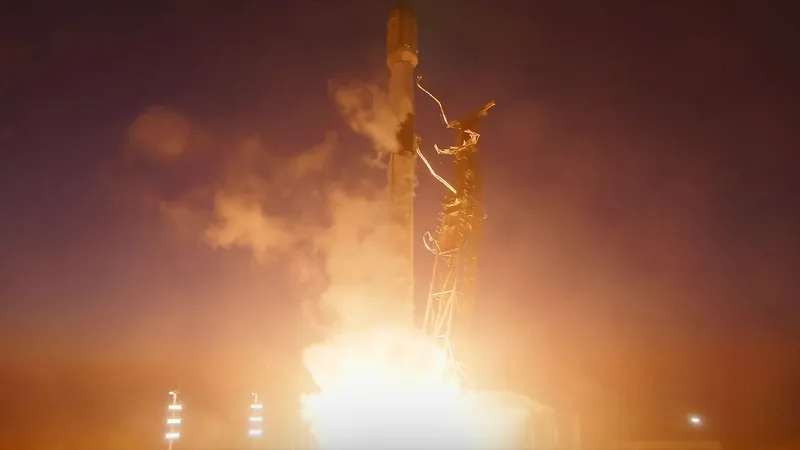
Major Setback for NASA's Psyche Spacecraft on Its Quest to a Mysterious Metal Asteroid
2025-05-01
Author: Amelia
NASA's Psyche spacecraft, currently over 150 million miles from Earth and en route to an unexplored metal asteroid, has encountered a significant issue: it abruptly halted its engine operations due to a propulsion system glitch.
In a recent update, NASA disclosed that the spacecraft ceased firing its plasma thrusters earlier this month after detecting a drop in fuel pressure. This revelation wasn't widely publicized until Wednesday, following a tweet from NASA’s science chief, Nicky Fox.
Engineers Investigate Fuel Pressure Drop
According to NASA, engineers are diligently working to analyze what caused a drop in fuel pressure within the spacecraft's propulsion system. The anomaly was first detected on April 1, affecting the xenon fuel line that supplies the spacecraft's four plasma thrusters.
The sensors reported a pressure decline from roughly 36 psi to 26 psi, prompting the spacecraft to automatically power down its thrusters to protect its systems.
Understanding Xenon Propulsion
Psyche employs solar electric propulsion, an innovative and efficient method utilizing solar energy and over a ton of xenon gas stored in large tanks. The spacecraft operates four thrusters that utilize electromagnetic fields to ionize and expel xenon gas, generating thrust.
Louise Prockter, director of NASA's planetary science division, assured that there's currently no impact on the spacecraft's trajectory. The plasma thrusters can be inactive until at least mid-June without drifting off course. Engineers have decided to keep the engines off until they fully understand the situation. If it turns out to be a fuel line issue, there are plans to switch to a backup.
Lessons in Redundancy
Prockter emphasized the importance of redundancy in mission designs, noting that these kinds of issues are anticipated in space exploration. "We don't have any concerns at the moment, but we’re keeping close tabs on it," she stated.
A Unique Mission Ahead
Each electric thruster on Psyche produces only 250 milli-newtons of thrust—equivalent to the weight of three quarters—but can operate continuously for months, making it an effective propulsion method for this long journey. Psyche, the spacecraft, is set on a monumentally ambitious mission; it will first swing by Mars next year to utilize the planet's gravity before heading deeper into the asteroid belt, aiming for an orbital insertion around the metal-rich asteroid Psyche in August 2029.
Launched in October 2023 aboard a SpaceX Falcon Heavy rocket, this mission is projected to cost over $1.4 billion, encompassing development, launch, operations, and a pioneering laser communications package.
Mysteries of the Psyche Asteroid
The Psyche asteroid, roughly the size of Massachusetts, orbits the Sun between Mars and Jupiter. With only nine out of approximately one million discovered asteroids having a metal-rich composition like Psyche, the mission promises to unveil significant insights.
Little is known about the asteroid itself, aside from estimations of its density and composition, prompting scientists to envision its landscape characterized by dramatic craters and ridges unlike any rocky bodies observed in our solar system.
Assuming NASA resolves the propulsion issues, in just over five years, Psyche could transform speculation into groundbreaking discoveries that could reshape our understanding of metallic worlds.









 Brasil (PT)
Brasil (PT)
 Canada (EN)
Canada (EN)
 Chile (ES)
Chile (ES)
 Česko (CS)
Česko (CS)
 대한민국 (KO)
대한민국 (KO)
 España (ES)
España (ES)
 France (FR)
France (FR)
 Hong Kong (EN)
Hong Kong (EN)
 Italia (IT)
Italia (IT)
 日本 (JA)
日本 (JA)
 Magyarország (HU)
Magyarország (HU)
 Norge (NO)
Norge (NO)
 Polska (PL)
Polska (PL)
 Schweiz (DE)
Schweiz (DE)
 Singapore (EN)
Singapore (EN)
 Sverige (SV)
Sverige (SV)
 Suomi (FI)
Suomi (FI)
 Türkiye (TR)
Türkiye (TR)
 الإمارات العربية المتحدة (AR)
الإمارات العربية المتحدة (AR)